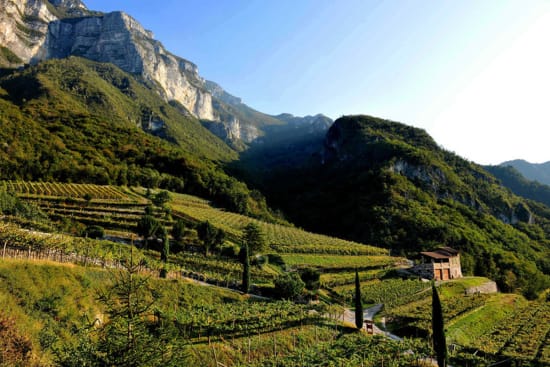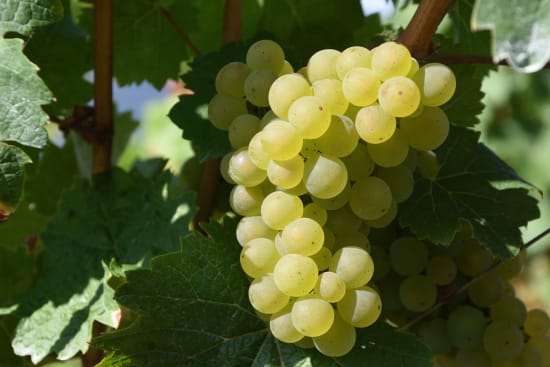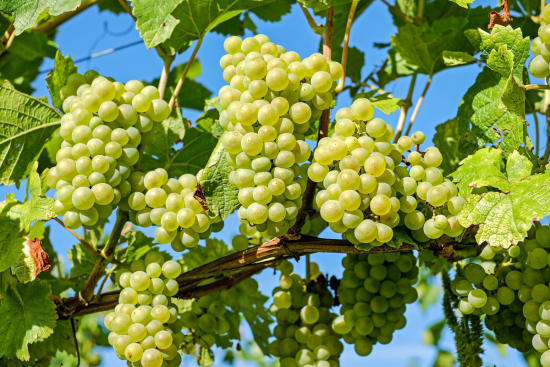Prosecco Albino Armani
When may a wine be labelled Prosecco? What is meant by Brut or Extra Dry? Who is Albino Armani? And what can dreams look like? Here you will find the answers.

Prosecco Albino Armani DOC (75 cl or 20 cl) – refined, sparkling, a pleasure!
If the bottle is not integrated in the flower gift, it will be delivered with an elegant gift box. Please pay attention in each case to the contents (75 cl or 20 cl).
The elegant Prosecco Albino Armani DOC Extra Dry comes from the Friuli region, from one of the five wineries
owned by Albino Armani. It is characterised by a fine bouquet of flowers and citrus, is tasty, long on the palate,
with a fine, persistent effervescence.
At a serving temperature of 8-10 degrees, it goes well with both an aperitif and the entire meal.

The grapes are cultivated in the hills of the DOC region in the Sequals area, where the soil is 80% gravel and stones.
This gives the Prosecco its pronounced mineral and very fresh note.
The grapes are harvested in September. The carbonic acid accumulates during a second round of fermentation in
stainless steel tanks. The result is a noble, independent Prosecco of exceptional character
that embodies the Italian approach to life and is appreciated even by connoisseurs.

By the way: This Prosecco is especially charming if you have it delivered with a trendy ice bucket, and maybe even with glasses.
But also a floral garnished ice bucket is a very stylish surprise.

Azienda Albino Armani – over 400 years of wine tradition
No one knows exactly when the Armani family first became involved in winemaking. The first written record dates back to 1607,
when Stefano Armani made a notarially certified gift of land with vines and trees to his son Domenico.
The history of the Armani family has been entwined with winemaking for over 400 years ever since then.

Today, the Armanis own five wineries. The oldest is located in Trentino, where the gently sloping hills are perfect for growing Chardonnay, Marzemino, Schiava and other varieties.
Three of the vineyards are in Veneto – in the Etsch valley, in Valpolicella and Treviso.
The diverse terrain means that the Armanis can cultivate the best grape varieties and produce wonderful wines such as Amarone.

The fifth winery is in the heart of the Grave DOC in Friuli, where our Prosecco comes from.
Here, the terrain is composed of stone and gravel, known as claps in the local dialect.
«It is a privilege to be a winemaker in these vineyard», says Albino Armani.
«But tireless effort and great passion is required for the vines to flourish and for grapes to become wine».

When may a wine be labelled Prosecco?
Prosecco has long been associated with Italy and the dolce vita. Consequently, it became so successful that more and more of it was
produced and it became cheaper and cheaper.
As there was soon more Prosecco than could be grown in the place of origin, something was wrong.
It turned out that the problem lay in the name. Prosecco did not just relate to where the wine came from, but also to the grape variety.
This is why the Italian Ministry of Agriculture brought things to a halt.

An order of 2009 stipulated that Prosecco is no longer the name of the grape variety, but a protected designation of origin for
quality-protected white wines from the Italian regions of Veneto and Friuli Giulia Venezia.
It also orders that at least 85% of the wine must come from the indigenous grape variety Glera in order to be a genuine Prosecco.
Finally, the wine must also be vinified and bottled in the region.

Look for the DOC or DOCG appellation to ensure that you are purchasing a high-quality sparkling wine.
Apropos high quality: our Prosecco Albino Armani has the DOC appellation and is made from 100% Glera grapes.

Brut, Extra Dry, Dry or Demi Sec?
Prosecco spumante is produced as Brut (dry), Extra Dry, Dry and Demi Sec (semi-sweet). These terms denote a wine’s sweetness.
Brut means that the Prosecco contains between 0 and 12 grams of sugar per litre. For Extra Dry, the residual sugar is between 12 and 17 grams,
between 17 and 32 grams for Dry and between 32 and 50 grams per litre for Demi Sec.

The word Prosecco has nothing to do with the Italian word «secco» for «dry».
Instead, Prosecco gets its name from the village of Prosecco, in the municipality of Trieste.
By the way: the Prosecco DOC Albino Armani we sell is Extra Dry.

Albino Armani: «I have the best job in the world»
Armani's wineries produce around one million bottles of wine per year, which are exported around the world. Albino Armani could have sat back and enjoyed the success.
But he is not that type of man. His curiosity is boundless. This is why he is always trying out something new.
Despite this, Albino Armani is far from being a typical businessman.
If you meet him at a wine exhibition, for example, you see a quiet, friendly and modest man.

He was almost born to his current profession. He was just a young boy when he experienced his first harvest.
Then he studied oenology and agriculture. In fact, he wanted to be an anthropologist.
But in those days, it was unusual if you trod a different path to what the family wanted.
Today, he does not regret his choice of career for a moment. «As far as I’m concerned, being a winemaker
is a privilege and a calling», says Albino Armani.
And: «I think I have the best job in the world. Because honestly, getting your hands dirty and
then seeing the resulting wine is without doubt the best job that fate could have had in store for me».

Vinum pucinum - the ancient Roman name for Prosecco
In Italy, Prosecco is presumed to have been known since ancient times, although then it was known as vinum pucinum.
During the Roman era, Castellum Pucinum, located to the north of Trieste, was the name for the modern Prosecco territory.
In his work Naturalis Historia, the Roman author Pliny the Elder (23-79 A.D.) mentioned it being rich in therapeutic properties.

Unfortunately, it is not known on which grape variety the wine was based. What is known, however,
is that Livia, also known as Augusta Giulia, the third wife of Emperor Augustus, regularly ordered this wine.
At the end of her long life (she lived to 86), she ascribed her great age to regular
consumption of this wine and recommended it to all as a veritable elixir of life.

According to Pliny, vinum pucinum was made in the Gulf of Trieste, not far from the stony hill at
the source of the Timavo river, close to Monfalcone in Friuli Giulia Venezia.
It is therefore entirely possible that vinum pucinum was the precursor to our Prosecco, which many others also regard as the elixir of life.
Into the Wine – the power of images (short video)
Like to take a short tour of Albino Armani's world? Then don't miss this video with a jazzy soundtrack.
The images are powerful and dreamy: with breathtaking scenery, people hard at work, expressive faces, an osteria in Trentino,
picturesque stone houses, cellars, horses and a dog who appears to live in a wine barrel like Diogenes.
More loving & high-quality additional gifts
Gottlieber specialties
Here you will find the story of a woman who developed normal wafers into a speciality and find out what makes our cocoa almonds so special.
Chocolate from Maestrani
Why is chocolate good for morning grouchs? Who paid with cocoa beans? And why do ladybirds bring good luck? Answers to these and other questions can be found here.
Honey from Bee-Family
Want to learn more about an irresistible honey? To dive into the world of honey, honey hunters and bee transhumance and know how to store honey? Read here.
Tea from Gottlieber
Which tea is called «gunpowder»? Which type of tea was picked by monkeys? And how is Moroccan tea made? Answers to these questions and more can be found here.
Red wines Amarone and Ripasso by Albino Armani
Here more about our red wines: the Azienda Albino Armani, a wine made from dehydrated grapes, the «accident» called Amarone and a film that will make you dream.
Prosecco Albino Armani
When may a wine be labelled Prosecco? What is meant by Brut or Extra Dry? Who is Albino Armani? And what can dreams look like? Here you will find the answers.
Prosecco Albino Armani Rosé DOC
What does it taste like? What goes well with it? What does Millesimato or SQNPI mean? And how sustainable is Armani? You can find the answers to these and other questions here.
Teddy bears
More about the «birth» and success story of the cute teddies as well as all kinds of information about teddy bear days, teddy bear records or teddy museums can be found here.
Avelines pralines - a melt-in-the-mouth treat
Are pralines your greatest pleasure? The ideal gift for special moments, a reward, an anti-stress remedy, or a bedtime snack? Then try our Avelines pralines, a premium treat of the finest quality.









